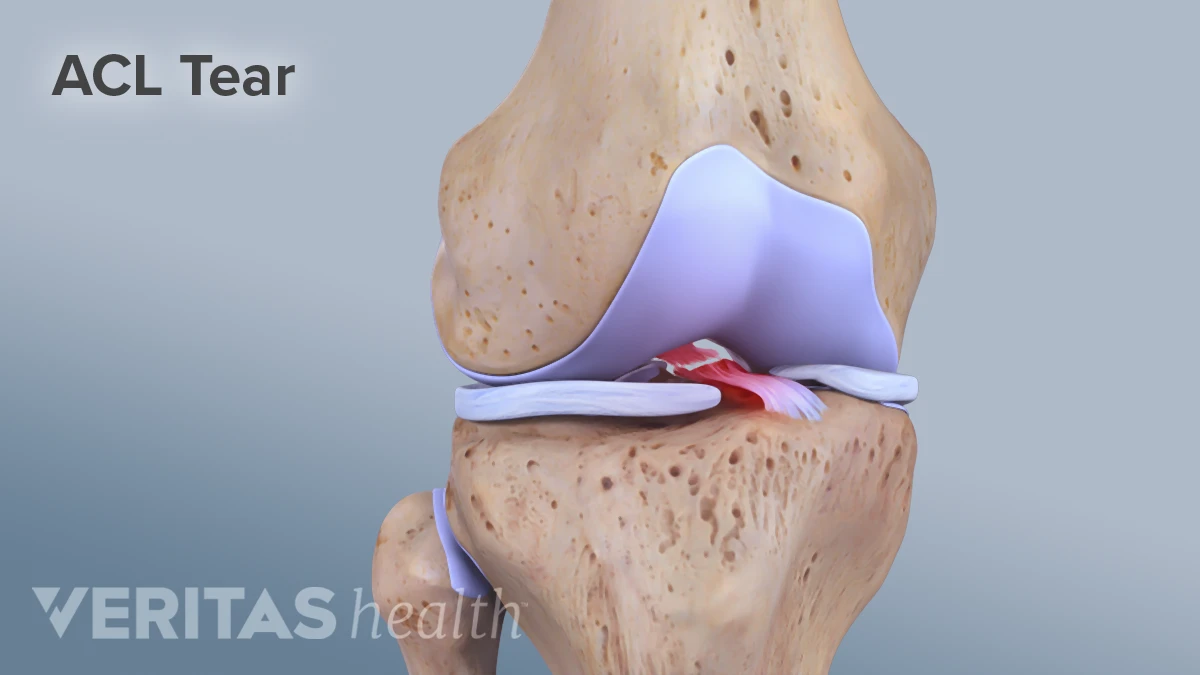An ACL tear, or torn anterior cruciate ligament, is one of the most common knee injuries.
ACL tears are common among athletes and occur more frequently among female athletes.
Ligaments connect bones to bones. As one of the four primary ligaments of the knee, the ACL connects the front top part of the shinbone to the back bottom part of the thigh bone. The ACL also keeps the shin from sliding forward, and provides rotational stability to the knee.
Causes and Risk Factors of ACL Tears
ACL injuries tend to happen more often in people who play high-impact sports where rapid pivoting and turning are common, such as basketball, football, skiing, and soccer.
In these instances, the tears tend to happen when a person is running and quickly changes direction, suddenly twists or cuts, or if they hyperextend their knee coming down from a jump.
The rest result from direct contact with an object or perhaps with another player while engaged in a sport. An example might be taking a direct hit to the knee during a football tackle.
- Being female (It may be that hormonal differences and differences in muscle strength play a role.)
- Playing soccer, football, or basketball
- Participating in gymnastics or downhill skiing
- Insufficient conditioning
- Playing with worn and poorly adjusted equipment
- Wearing improperly fitted footwear
- Playing on artificial turf
Duration of ACL Tears
In general, recovery from an ACL tear generally takes about nine months, but this varies from person to person.
Complications of ACL Tears
People who experience an ACL injury are at higher risk of developing osteoarthritis, more specifically referred to as post-traumatic osteoarthritis (PTOA) in the knee.
- Infection
- Bleeding
- Numbness
- Viral transmission
- Blood clot
- Recurrent instability
- Knee stiffness
- Bone growth problems in young children and adolescents (ACL surgery is sometimes delayed until a child’s bones have fully matured.)
- Kneecap pain
Related Conditions and Causes of ACL Tears
Resources We Love
American Orthopaedic Society for Sports Medicine (AOSSM)
This sports medicine organization’s members include orthopaedic surgeons and other professionals who work to promote advances in the science and practice of sports medicine. On the organization’s Stop Sports Injuries site, you can find valuable information about ways to prevent sports injuries as well as links to tools to help you find sports medicine specialists, orthopaedic surgeons, pediatric orthopaedic specialists, and physical therapists.
Arthritis Foundation
A great resource for finding out more about osteoarthritis, a complication of ACL tear, including the latest treatments and therapies.
The Arthroscopy Association of North America (AANA)
AANA is an organization of more than 5,000 orthopaedic surgeons and medical professionals who seek to advance the field of minimally-invasive orthopaedic surgery to improve patient outcomes. If you are contemplating surgery for your ACL tear, the site can provide you with valuable information about the surgery potential risks and recovery. Their Find A Doctor tool allows you to search for board certified surgeons in your area.
OrthoInfo
This site from the American Academy of Orthopaedic Surgeons (AAOS) is a great resource for articles, videos, and resources related to bone and joint health.
Editorial Sources and Fact-Checking
References
- ACL Injury. UCSF Health.
- Anterior Cruciate Ligament (ACL) Injuries. OrthoInfo. March 2014.
- Sports Tip: ACL Injury Prevention in Youth Athletes [PDF]. American Orthopaedic Society for Sports Medicine. 2019.
- ACL Injury. Mayo Clinic. March 30, 2019.
- ACL (Anterior Cruciate Ligament) Tears: Diagnosis and Tests. Cleveland Clinic. October 19, 2020.
- ACL Injury Diagnosis. UCSF Health.
- ACL Injury: Does It Require Surgery? OrthoInfo. September 2009.
- Sports Tip: The Injured ACL [PDF]. American Orthopaedic Society for Sports Medicine. 2016.
- ACL Reconstruction. Mayo Clinic. December 11, 2018.
- Huang Y, Jung J, Mulligan CMS, et al. A Majority of Anterior Cruciate Ligament Injuries Can Be Prevented by Injury Prevention Programs: A Systematic Review of Randomized Controlled Trials and Cluster-Randomized Controlled Trials With Meta-Analysis. The American Journal of Sports Medicine. May 2020.
- Wang L, Zeng N, Yan ZP, et al. Post-Traumatic Osteoarthritis Following ACL Injury. Arthritis Research & Therapy. March 24, 2020.
- ACL Injury Treatments. UCSF Health.
- Sepúlveda F, Sánchez L, Eduardo A, Micheo W. Anterior Cruciate Ligament Injury: Return to Play, Function, and Long-Term Considerations. Current Sports Medicine Reports. May-June 2017.
- Braden C. Fleming BC., Phd, to BE Recognized by the AAOS and the OREF for Research Into the Long-Term Outcomes of ACL Reconstruction With a Focus on Post-Traumatic Osteoarthritis. American Academy of Orthopaedic Surgeons. February 5, 2020.
- Montalvo AM, Schneider DK, Webster KE, et al. Anterior Cruciate Ligament Injury Risk in Sport: A Systematic Review and Meta-Analysis of Injury Incidence by Sex and Sport Classification. Journal of Athletic Training. May 2019.
Sources
- Filbay SR, Grindem H. Evidence-Based Recommendations for the Management for Anterior Cruciate Ligament (ACL) Rupture. Best Practice & Research: Clinical Rheumatology. February 2019.
- American Academy of Family Physicians
- Johns Hopkins Medicine
- MedlinePlus
- Yale Medicine













































